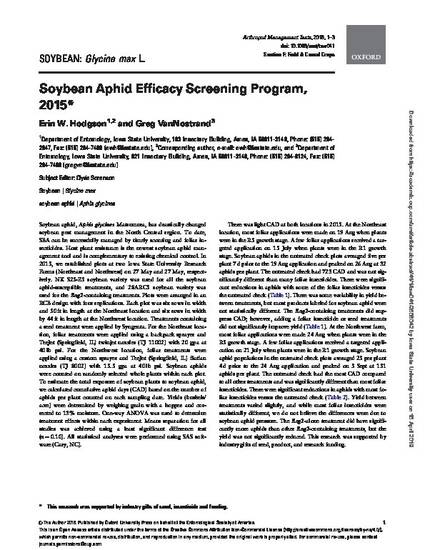
Soybean aphid, Aphis glycines Matsumura, has drastically changed soybean pest management in the North Central region. To date, SBA can be successfully managed by timely scouting and foliar insecticides. Host plant resistance is the newest soybean aphid management tool and is complementary to existing chemical control. In 2015, we established plots at two Iowa State University Research Farms (Northeast and Northwest) on 27 May and 27 May, respectively. NK S25-E5 soybean variety was used for all the soybean aphid-susceptible treatments, and 28ARC5 soybean variety was used for the Rag2 -containing treatments. Plots were arranged in an RCB design with four replications. Each plot was six rows in width and 50 ft in length at the Northeast location and six rows in width by 44 ft in length at the Northwest location. Treatments containing a seed treatment were applied by Syngenta. For the Northeast location, foliar treatments were applied using a backpack sprayer and TeeJet (Springfield, IL) twinjet nozzles (TJ 11002) with 20 gpa at 40 lb psi. For the Northwest location, foliar treatments were applied using a custom sprayer and TeeJet (Springfield, IL) flatfan nozzles (TJ 8002) with 15.5 gpa at 40 lb psi. Soybean aphids were counted on randomly selected whole plants within each plot. To estimate the total exposure of soybean plants to soybean aphid, we calculated cumulative aphid days (CAD) based on the number of aphids per plant counted on each sampling date. Yields (bushels/acre) were determined by weighing grain with a hopper and corrected to 13% moisture. One-way ANOVA was used to determine treatment effects within each experiment. Means separation for all studies was achieved using a least significant difference test (α = 0.10). All statistical analyses were performed using SAS software (Cary, NC).
Available at: http://works.bepress.com/erin_hodgson/315/

This article is published as Hodgson, E. W., and G VanNostrand. Soybean Aphid Efficacy Screening Program, 2015. Arthropod Management Tests 41 (2016): tsw041. doi: 10.1093/amt/tsw041.